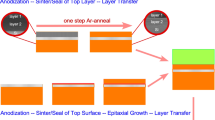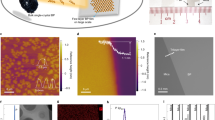Abstract
A PROBLEM in the production of transistor structures by diffusion is to control the surface concentration at a required level (about 5 × 1018 atoms/cm.3 in a typical case). Diffusion of phosphorus by conventional methods produces concentrations between 1020–1021 atoms/cm.3 due to the high solubility of the phosphorus at the diffusion temperatures1. A method of obtaining desired values of surface concentration over the range 5 × 1016 to 5 × 1018 atoms/cm.3 by controlling the phosphorus vapour pressure has been successfully evolved.
This is a preview of subscription content, access via your institution
Access options
Subscribe to this journal
Receive 51 print issues and online access
$199.00 per year
only $3.90 per issue
Buy this article
- Purchase on Springer Link
- Instant access to full article PDF
Prices may be subject to local taxes which are calculated during checkout
Similar content being viewed by others
References
Fuller and Ditzenberger, J. App. Phys., 27, 544 (1956).
MacRae and Vanvoorhis, J. Amer. Chem. Soc., 43, 547 (1921).
Smits and Miller, Phys. Rev., 104, 1242 (1956); 107, 65 (1957).
Author information
Authors and Affiliations
Rights and permissions
About this article
Cite this article
COUPLAND, M. Control of Surface Concentration in the Diffusion of Phosphorus in Silicon. Nature 181, 1331–1332 (1958). https://doi.org/10.1038/1811331b0
Issue Date:
DOI: https://doi.org/10.1038/1811331b0
Comments
By submitting a comment you agree to abide by our Terms and Community Guidelines. If you find something abusive or that does not comply with our terms or guidelines please flag it as inappropriate.



